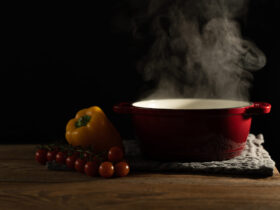We use them daily, often without much thought – eggs. But have you ever delved deeper into the topic of eggs and egg substitutes? In this article, I’ll summarize the essential background knowledge about eggs and their replacement options, ranging from taste to technical aspects.
Why Animal Welfare Matters
Naturally, animal welfare is paramount when it comes to raising animals for egg production. However, there’s another crucial aspect: the quality of the eggs we consume. Conventional mass production often comes with poor conditions and requires the use of medications, whose residues can also be found in the eggs. Therefore, it’s important to look for labels like Demeter or Bioland to ensure that the animals are raised under good conditions.
What are eggs?
Eggs are not only a product of chickens but also of many other animals and fish. An egg consists of egg white surrounding the inner yolk, all enclosed by an eggshell. But what exactly is in the yolk? It contains about 50% water, 15% protein, and 33.5% fat, with up to 10% lecithin. This composition makes the yolk an important component of many recipes, especially as an emulsifier in mayonnaises, sauces, and dressings.

The Color of the Yolk - Organic Makes a Difference
The color of the yolk depends on the carotenoids that the chickens absorb from their feed. While organic chickens are not exposed to additional dyes and therefore can reach a maximum of level 9 or 10 in color intensity, conventional operations may add dyes that result in a more intense color. This difference shows how the conditions of raising animals can affect the quality of eggs.
Add Your Heading Text Here
How Long Are Eggs Good For?
Eggs have a shelf life of 4 weeks from the laying date, which determines the printed expiration date. Grade A quality means that the egg can be traded up to 3 weeks after laying, while Grade A extra can only be traded up to 9 days after laying. Eggs remain edible and fresh for up to 6 weeks from the laying date when left untouched. They can last approximately 3 months when stored in the refrigerator.
In Germany, eggs are not washed, as doing so would remove their natural protective coating. For this reason, eggs are sold unrefrigerated in our country. In some countries, eggs are washed and bleached, but they must be refrigerated afterward, as washing makes the shell permeable and susceptible to bacterial contamination.
The Classic Freshness Test
The Water Test – Place the egg in water. Fresh eggs sink to the bottom, while eggs that are 2-3 weeks old may tilt upwards but remain at the bottom. A spoiled egg will float to the surface.

Processing Temperature
Eggs should ideally be processed at room temperature. Emulsions are less successful with cold eggs, cold eggs crack more easily when boiled due to temperature shock, and egg whites whip better at room temperature.
Coagulation and Temperatures
Cold Eggs
Cold eggs are only suitable as emulsifiers to bind ingredients like mayonnaise. When cold, the egg whites are already busy binding the water present in the egg.
60°C-80°C:
Coagulation begins at 60°C, primarily used in the preparation of liquid foods like sauces (Hollandaise, Sabayon, custards). Stirring is essential during this phase. Coagulation ends at 80°C.
Above 80°C:
At temperatures above 80°C, the egg’s structure becomes firmer, resembling a sponge. This sponge-like structure can bind 2-2.5 times its weight. For example, you’ll need approximately 50g of egg for 100g of liquid (e.g., milk). When mixed with milk or cream, the egg begins to set at around 90°C.

Egg Substitutes: How to Replace Eggs in Recipes
Finding suitable egg substitutes is crucial for those with dietary restrictions or allergies, as well as for vegan baking. Fortunately, replacing eggs in recipes is easier than you might think. By understanding the components of eggs and their functions in recipes, you can effectively substitute them with various ingredients. In this article, we’ll explore how to replace whole eggs, egg yolks, and egg whites in different culinary applications.
Replacing whole eggs
Whole eggs consist of water, fat, and protein in specific proportions. Here’s how you can replace them in various applications:
As a Liquid:
In batters and doughs, eggs serve as a source of moisture. You can replace one egg with approximately 50g of any liquid or puree. Common substitutes include milk, fruit purees, or vegetable broth.
For Binding:
In cooked batters and mixtures, eggs provide binding properties. You can replace one egg with either 10g starch, 15g flour, 0.5g agar agar, 0.5g xanthan gum, or 0.5g locust bean gum. These ingredients help bind the mixture together effectively.
For Emulsification:
In vegan mayonnaises or sauces, eggs act as emulsifiers. To replace one egg, you can use 10g soy milk, 10g aquafaba (the liquid from canned chickpeas), or 5g pure soy lecithin. These ingredients help stabilize and emulsify the mixture.
Replacing egg yolks
Replacing Egg Yolks:
Egg yolks contribute to the creaminess and richness of dishes. Here’s how you can replace them:
For Creaminess:
To make sauces creamier, you can substitute one egg yolk with approximately 20g of heavy cream or vegan cream. These alternatives mimic the texture and richness of egg yolks effectively.
For Emulsification:
If you need egg yolks as emulsifiers, you can use the same substitutes as for whole eggs: 10g soy milk, 10g aquafaba, or 5g soy lecithin.
Replacing egg whites
Egg whites are often used for their ability to create light and fluffy textures, especially in meringues and soufflés. Here’s how you can replace them:
For Lightening (Meringue):
Aquafaba, the liquid from canned chickpeas, is an excellent substitute for egg whites. You can use 35g of aquafaba for each egg white. Simply whip it as you would egg whites until stiff peaks form.














Leave a Reply
View Comments